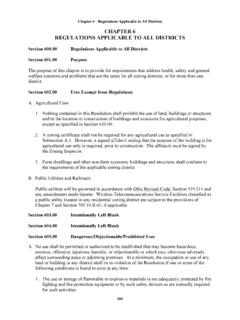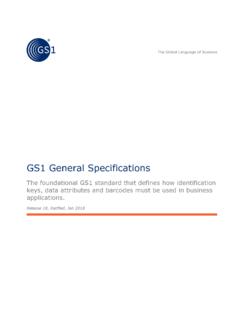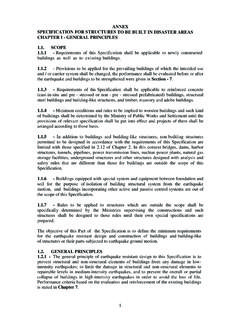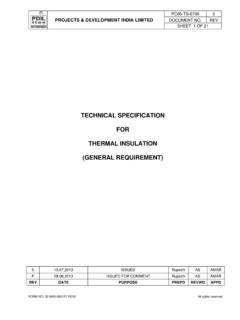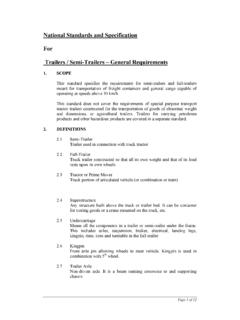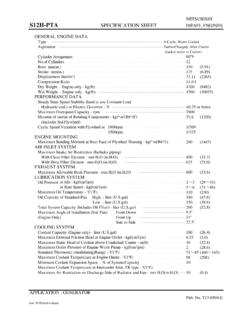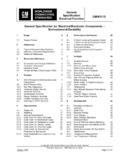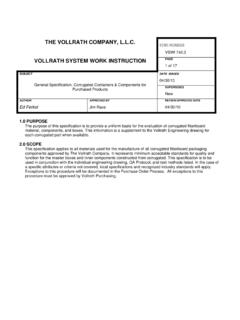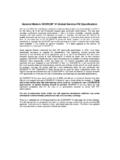Transcription of SCBA BID SPECIFICATION General Self-Contained …
1 SCBA BID SPECIFICATION . General Self-Contained breathing apparatus requirements The purpose of this bid SPECIFICATION is to establish the minimum requirements for an open- circuit Self-Contained breathing apparatus (SCBA). The SCBA shall consist of the following major sub-assemblies: (1) full facepiece assembly; (2) a removable facepiece-mounted, positive pressure breathing regulator with air-saver switch; (3) an automatic dual path redundant pressure reducing regulator; (4) end-of-service time indicators; (5) a harness and backframe assembly for supporting the equipment on the body of the wearer; (6) a shoulder strap mounted, remote gauge indicating cylinder pressure; (7) a rapid intervention crew/universal air connection (RIC/UAC);. and (8) cylinder and valve assembly for storing breathing air under pressure. The successful bidder agrees to provide, at their own expense, a factory trained instructor for such time as the respirator user shall require complete instruction in the operation and maintenance of the respirator.
2 Any exceptions to these specifications must be detailed in a separate attachment. Failure to do so will automatically disqualify the bidder. The successful bidder must be a sales distributor, authorized by the manufacturer, to sell the equipment specified herein. The SCBA shall maintain all NIOSH standards with any of the following types of cylinders listed as provided by the SCBA manufacturer. Approvals The SCBA shall be approved to NIOSH 42 CFR, Part 84 for chemical, biological, radiological and nuclear protection (CBRN). The SCBA shall be compliant to the NFPA 1981, 2013 Edition, Standard on Open-Circuit Self-Contained breathing apparatus for Emergency Services. The SCBA shall be compliant to the NFPA 1982, 2013 Edition, Standard on Personal Alert Safety Systems. All electronic components shall be approved for Intrinsic Safety under UL 913 Class I, Groups C and D, Class II, Groups E, F and G, Hazardous locations.
3 Quantities 10 self contained breathing apparatus (see below for SPECIFICATION ). 10 Face Pieces with right bracket 10 4500 PSI, 4545 minute bottles 10 Voice Amps))00) Epic 3 Voice Amp Delivery time is 30 to 45 days. 1. Required Components Facepiece The facepiece shall have a large diameter inlet serving as the female half of a quarter (1/4) turn coupling which mates with the positive pressure breathing regulator. The facepiece shall be approved for use with multiple respiratory applications to enable the same user to switch from one application to another without the use of tools and without doffing the facepiece. The full facepiece assembly shall fit persons of varying facial shapes and sizes with minimal visual interference. The full facepiece assembly shall be available in three sizes marked S for Small, M for Medium, and L for Large. The facepiece sizes shall be easily identifiable through a color-coding scheme.
4 The facepiece assembly, including head harness, shall be latex free. The facepiece series shall have a faceseal that is secured to the lens by a U-shaped channel frame that is retained to the lens using two fasteners. The faceseal shall be a reverse reflex design for enhanced fit and comfort. The facepiece shall contain inhalation valves that are readily visible to enable quick visual inspection. The lens shall be a single, replaceable, modified cone configuration constructed of a non-shatter type polycarbonate material. In accordance with NIOSH 42 CFR part 84, the facepiece meets penetration and impact requirements , including compliance with ANSI 2010. The lens shall have a coating to resist abrasion and chemical attack and meet the requirements of NFPA-1981, for lens abrasion. The lens shall have an internal anti-fog coating to reduce fogging of the lens. Mutli-directional voicemitters shall be mounted on both sides of the facepiece and ducted directly to an integral silicone nosecup to enhance voice transmission.
5 The facepiece assembly shall be able to incorporate multiple electronic communications options (amplification, radio interface, wireless, etc.) without affecting NIOSH approvals or NFPA/CBRN approvals where applicable. The facepiece shall enable the transmission of communications bracket on either the right or left side. The head harness shall be a five-point suspension made in the fashion of a net hood to minimize interference between securing of the facepiece and the wearing of head protection, and be constructed of a para-aramid material for fire, first responder and CBRN applications. 2. Mask-Mounted Regulator The facepiece-mounted positive pressure- breathing regulator shall supply and maintain air to the facepiece to satisfy the needs of the user at a pressure greater than atmospheric by no more than inches of water pressure static. The breathing regulator shall maintain positive pressure during flows of up to 500 standard liters per minute.
6 The regulator shall also meet or exceed a dynamic flow requirement of remaining positive while supplying a minute volume of 160 liters. The breathing regulator shall have attached a low pressure hose which shall be threaded through the left shoulder strap to couple to the pressure reducing regulator mounted on the backframe.. The low-pressure hose shall be equipped with a swivel attachment at the facepiece mounted regulator. The regulator shall connect to the facepiece by way of a quarter (1/4) turn coupling. The user shall hear an audible sound when the regulator is attached correctly to the facepiece. The regulator shall be equipped with a doughnut-shaped gasket which provides a seal against the mating surface of the facepiece. The regulator cover shall be fabricated of a flame resistant, high impact plastic. The breathing regulator shall have a demand valve to deliver air to the user, activated by a diaphragm responsive to respiration.
7 The demand valve shall use an extended temperature range dynamic O-ring seal composed of a fluorosilicone elastomer. The diaphragm shall include the system exhalation valve and shall be constructed from a high strength butyl elastomer. A purge valve shall be situated at the inlet of the breathing regulator and shall be capable of delivering airflow of between 125 and 175 standard liters per minute. The breathing regulator shall be arranged to direct the incoming air over the inner surface of the facepiece for defogging purposes. The components of the breathing regulator shall be constructed of materials that are not vulnerable to corrosion. The flame resistant cover shall contain an air saver switch and pressure demand bias mechanism. It shall reactivate and supply air only in the positive pressure mode when the wearer affects a face seal and inhales. This device shall not affect the breathing flow though the system while in operation.
8 3.. Pressure Reducer with CGA Cylinder Connection The pressure-reducing regulator shall be mounted at the waist on the backframe and be coupled to the cylinder valve through a short length of internally armored high pressure hose with a hand coupling for engagement and sealing within the cylinder valve outlet. In lieu of a manual by- pass, the pressure-reducing regulator shall include a back-up pressure-reducing valve connected in parallel with the primary pressure reducing valve and an automatic transfer valve for redundant control. The back-up pressure reducing valve shall also be the means of activating the low-pressure alarm devices in the facepiece-mounted breathing regulator. This warning shall denote a switch from the primary reducing valve to the back-up reducing valve whether from a malfunction of the primary reducing valve or from low cylinder supply pressure. A press-to-test valve shall be included to allow bench testing of the back-up reducing valve.
9 The pressure-reducing regulator shall have extended temperature range dynamic O-ring seals composed of fluorosilicone elastomer. The pressure reducing regulator shall have incorporated a reseatable over-pressurization relief valve which shall prevent the attached low pressure hose and facepiece-mounted breathing regulator from being subjected to high pressure. End-of-Service Time Indicator (EOSTI). The SCBA shall have two end-of-service time indicators (EOSTI), a tactile alarm and a Heads- Up Display (HUD). The primary EOSTI shall be the integral low-pressure alarm device that shall combine an audible alarm with simultaneous vibration of the facepiece. The primary EOSTI shall be located in the Facepiece-Mounted Positive Pressure Regulator. This alarm device shall indicate either low cylinder pressure (33% +5%, -0%) or primary first stage regulator failure. The HUD shall serve as the secondary EOSTI indicator.
10 The HUD shall be powered by the SCBA's single power supply. It shall be mounted in the user's field of vision on the Facepiece- Mounted Positive Pressure Regulator. It shall display cylinder pressure in increments of 100%, 75%, 50% and 33%. The display shall not have a numerical representation of bottle pressure. At full bottle pressure, two green Light Emitting Diodes (LED) shall be illuminated. At three- quarter bottle pressure, one green LED shall be illuminated. At one-half bottle pressure, one yellow LED shall be illuminated and flash at a rate not to exceed one (1x) time per second. At one-third bottle pressure, one red LED shall be illuminated and flash at a rate not to exceed ten (10x) times per second. The HUD shall have a low battery indication that is distinct and distinguishable from the bottle pressure indications. 4. Harness and Backframe Assembly A lightweight, lumbar support style backframe and harness assembly shall be used to carry the cylinder and valve assembly and the pressure reducing regulator assembly.
